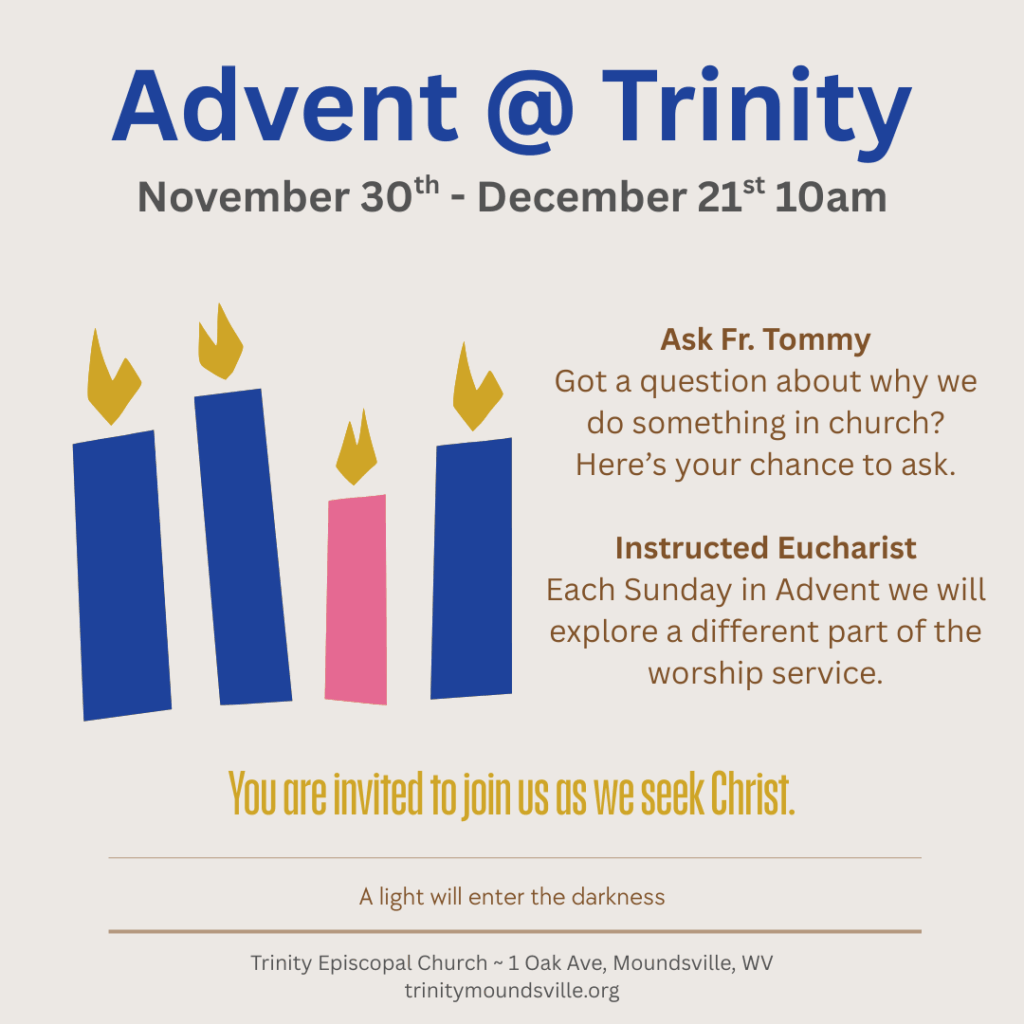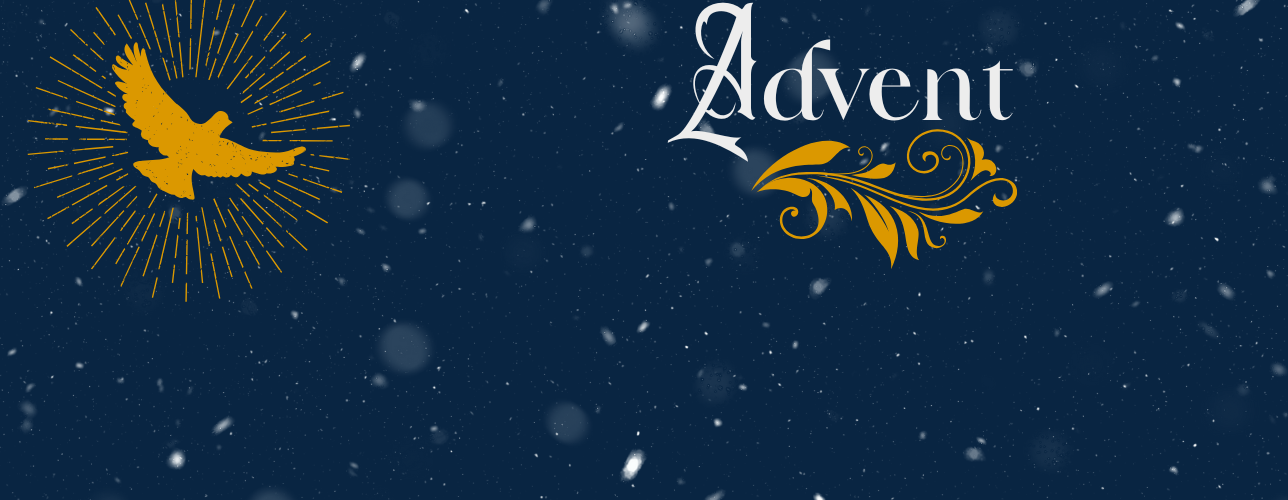Advent Offerings at Trinity
Fire in the hearth. Bread on the table. Questions in the air. That’s the kind of Advent I want for us at Trinity, not a sleepy countdown but a living rehearsal for God-with-us—curiosity turned toward the altar, hearts turned toward one another.

Advent Series: Instructed Eucharists + “Ask Fr. Tommy”
This Advent we’re breaking open the liturgy—step by step, prayer by prayer—so we don’t merely go through the service; we let the service go through us. Each Sunday, we’ll pause at one major moment of the Eucharist and name what’s happening, why it matters, and how our bodies, voices, and choices participate in the grace God is already pouring out.
And because worship invites conversation, not silence-by-default, we’ll add “Ask Fr. Tommy” during the announcements. Your questions about the service, our traditions, the symbols on the vestments, the choreography at the altar—bring them. Write them down and drop them in the blue bag in the sanctuary. No filter. No shame. If you’ve wondered about it, someone else has too.
How the four Sundays will unfold
Week 1: Crossing the Threshold — Space, Symbols, and the Advent Wreath
We begin where worship begins: at the door. Narthex, nave, chancel, sanctuary—these aren’t museum labels. They’re a map for belonging. The font tells us we enter by mercy. The Advent wreath refuses to rush the Light. The altar anchors us like a kitchen table where the whole household is welcome. We’ll talk about posture (standing, kneeling, sitting), about making the sign of the cross (optional, always), about why the Gospel book is kissed, and why color—deep blue for Advent—does more than decorate; it teaches our bodies to feel hope. “They devoted themselves to the apostles’ teaching and fellowship, to the breaking of bread and the prayers” (Acts 2:42, NRSV). Space shapes devotion.
Questions you might ask:
- Why do we bow to the altar but not always to the processional cross?
- What’s inside the aumbry?
- Why does the Advent wreath sometimes have a rose candle?
Week 2: The Liturgy of the Word — Listening for a Living God
Scripture isn’t a history lesson read at arm’s length. It’s a conversation God insists on having with a people God refuses to abandon. Lectionary readings set the table—Hebrew Scriptures, Psalm, Epistle, Gospel—so the story can read us even as we read it. The sermon is not a TED Talk with hymn breaks. It’s shared work: preacher and congregation listening for the Spirit until the text catches fire. Then the Creed and the Prayers of the People pull us from “I” to “we.” “Were not our hearts burning within us… while he was opening the scriptures to us?” (Luke 24:32, NRSV). That’s the goal: burning hearts that pray boldly.
Questions you might ask:
- Why do we say the Creed if we’re still wrestling with parts of it?
- Can I remain seated for the Gospel if standing is difficult?
- How are the weekly readings chosen?
Week 3: The Great Thanksgiving — Offertory to Amen
This is the beating heart. We bring bread, wine, and money, yes—but also anger, loneliness, gratitude, unfinished apologies, raw hope. The Offertory is not a liturgical halftime; it’s the moment we hand God our real lives. Then the Eucharistic Prayer names God’s relentless faithfulness, calls down the Spirit (that’s the epiclesis), and we join heaven’s song in the Sanctus. We remember Jesus, break the bread, and proclaim a death that opens life. The Fraction is the scandal: wholeness comes through brokenness. Communion is not a prize for the perfect; it’s food for the journey. “He had been made known to them in the breaking of the bread” (Luke 24:35, NRSV). Known—not as an idea, but as a presence you can taste.
Questions you might ask:
- What changes when the priest places a hand over the bread and cup?
- Why gluten-free hosts?
- May my child receive? (Short answer: yes. Longer answer: come and see.)
Week 4: Sent on Purpose — Peace, Blessing, and Dismissal
The Peace isn’t a coffee hour preview. It’s reconciliation enacted before we approach the table. The Blessing refuses despair the last word. And the Dismissal (“Go in peace…”) is a commissioning, not a curtain call. The liturgy doesn’t end; it spills into Monday—kitchen tables, hospital rooms, classrooms, street corners. “Always be ready to make your defense to anyone who demands from you an accounting for the hope that is in you” (1 Peter 3:15, NRSV). Worship trains that readiness.
Questions you might ask:
- Why do we say “And also with you” so often?
- What if I don’t feel peaceful at the Peace?
- Why are there different dismissal options?
Why this matters now
Because God isn’t playing hide-and-seek with us. Because Advent pulls the future into the present and demands attention. Because our habits at prayer rewrite our habits in public. If we practice confession, we get better at truth. If we practice peace, we get braver at repair. If we practice thanksgiving, we get freer with money, time, and compassion. Liturgy is formation with a pulse.
How “Ask Fr. Tommy” works
- Write a question—anything about worship, sacraments, church architecture, vestments, candles, colors, postures, prayer, Scripture, the lectionary, the Prayer Book, incense, you name it.
- Drop it in the BLUE BAG in the sanctuary. Make it a ritual: scribble, fold, offer.
- Listen during announcements each Sunday in Advent. I’ll read a few, give straight answers, and—when needed—say, “Let’s learn this together,” and then we will.
Bring your kids’ questions too. “Why does the priest wash hands?” “What’s that bell for?” “Do angels come to church?” Children often ask what adults are afraid to say out loud. Let them lead us into honest wonder.
What this invites from you
- Attention. Look, really look, at what we do each week.
- Participation. Sing, respond, pray, taste, kneel or stand as you are able—fully present.
- Questions. Not to win arguments, but to deepen love.
- Offering. Place your whole life on that plate: story, grief, paycheck, laughter. God can work with real.
We’re not polishing a performance. We’re learning a language—the Church’s mother tongue—so we can speak hope fluently in Marshall County and beyond. Advent will move fast. Don’t coast. Engage.
Find a pen. Write the question that’s been tugging at you for years. Fold the paper. Walk it to the blue bag like you’re bringing an offering—because you are. Then come back to your pew ready to be surprised. The table is set. The story is alive. Let’s learn it, love it, and live it—together.

